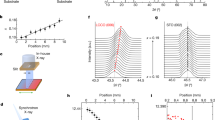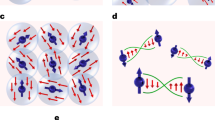Abstract
High-temperature (high- Tc) superconductivity in the copper oxides arises from electron or hole doping of their antiferromagnetic (AF) insulating parent compounds. The evolution of the AF phase with doping and its spatial coexistence with superconductivity are governed by the nature of charge and spin correlations, which provides clues to the mechanism of high- Tc superconductivity. Here we use neutron scattering and scanning tunnelling spectroscopy (STS) to study the evolution of the bosonic excitations in electron-doped superconductor Pr0.88LaCe0.12CuO4−δ with different transition temperatures (Tc) obtained through the oxygen annealing process. We find that spin excitations detected by neutron scattering have two distinct modes that evolve with Tc in a remarkably similar fashion to the low-energy electron tunnelling modes detected by STS. These results demonstrate that antiferromagnetism and superconductivity compete locally and coexist spatially on nanometre length scales, and the dominant electron–boson coupling at low energies originates from the electron-spin excitations.
This is a preview of subscription content, access via your institution
Access options
Subscribe to this journal
Receive 12 print issues and online access
$209.00 per year
only $17.42 per issue
Buy this article
- Purchase on Springer Link
- Instant access to full article PDF
Prices may be subject to local taxes which are calculated during checkout




Similar content being viewed by others
References
Lee, P. A., Nagaosa, N. & Wen, X. G. Doping a Mott insulator: Physics of high-temperature superconductivity. Rev. Mod. Phys. 78, 17–85 (2006).
Armitage, N. P., Fournier, P. & Greene, R. L. Progress and perspectives on the electron-doped cuprates. Rev. Mod. Phys. 82, 2421–2487 (2010).
Capone, M. & Kotliar, G. Competition between d -wave superconductivity and antiferromagnetism in the two-dimensional Hubbard model. Phys. Rev. B 74, 054513 (2006).
Demler, E., Hanke, W. & Zhang, S-C. SO(5) theory of antiferromagnetism and superconductivity. Rev. Mod. Phys. 76, 909–974 (2004).
Weber, C., Haule, K. & Kotliar, G. Strength of correlations in electron and hole doped cuprates. Nature Phys. 6, 574–578 (2010).
Tranquada, J. M., Sternlieb, B. J., Axe, J. D., Nakamura, Y. & Uchida, S. Evidence for stripe correlations of spins and holes in copper oxide superconductors. Nature 375, 561–563 (1995).
Kivelson, S. A. et al. How to detect fluctuating stripes in the high-temperature superconductors. Rev. Mod. Phys. 75, 1201–1241 (2003).
Pintschovius, L. & Reichardt, W. in Physical Properties of High Temperature Superconductors, Vol. IV (ed. Ginsberg, D. M.) 295 (World Scientific, 1994).
Fujita, M. et al. Magnetic and superconducting phase diagram of electron-doped Pr1−xLaCexCuO4 . Phys. Rev. B 67, 014514 (2003).
Kang, H. J. et al. Microscopic annealing process and its impact on superconductivity in T′ -structure electron-doped copper oxides. Nature Mater. 6, 224–229 (2007).
Li, S. L. Impact of oxygen annealing on the heat capacity and magnetic resonance of superconducting Pr0.88LaCe0.12CuO4−δ . Phys. Rev. B 78, 014520 (2008).
Dai, P. et al. Electronic inhomogeneity and competing phases in electron-doped superconducting Pr0.88LaCe0.12CuO4−δ . Phys. Rev. B 71, 100502(R) (2005).
Wilson, S. D. et al. Evolution of low-energy spin dynamics in the electron-doped high-transition temperature superconductor Pr0.88LaCe0.12CuO4−δ . Phys. Rev. B 74, 144514 (2006).
Wilson, S. D. et al. Resonance in the electron-doped high-transition-temperature superconductor Pr0.88LaCe0.12CuO4−δ . Nature 442, 59–62 (2006).
Wilson, S. D. et al. High-energy spin excitations in the electron-doped superconductor Pr0.88LaCe0.12CuO4−δ with Tc=21 K. Phys. Rev. Lett 96, 157001 (2006).
Dagan, Y., Qazilbash, M. M., Hill, C. P., Kulkarni, V. N. & Greene, R. L. Evidence for a quantum phase transition in Pr2−xCexCuO4−δ from transport measurements. Phys. Rev. Lett. 92, 167001 (2004).
Motoyama, E. M. et al. Spin correlations in the electron-doped high-transition-temperature superconductor Nd2−xCexCuO4 . Nature 445, 186–189 (2007).
Niestemski, F. C. et al. A distinct bosonic mode in an electron-doped high-transition-temperature superconductor. Nature 450, 1058–1061 (2007).
Zhao, G. M. Fine structure in the tunneling spectra of electron-doped cuprates: No coupling to the magnetic resonance mode. Phys. Rev. Lett 103, 236403 (2009).
Bardeen, J., Cooper, L. N. & Schrieffer, J. R. Theory of superconductivity. Phys. Rev. 108, 1175–1204 (1957).
McMillan, W. L. & Rowell, J. M. Lead phonon spectrum calculated from superconducting density of states. Phys. Rev. Lett. 14, 108–112 (1965).
Maier, T. A., Poilblanc, D. & Scalapino, D. J. Dynamics of the pairing interaction in the Hubbard and t−J models of high-temperature superconductors. Phys. Rev. Lett 100, 237001 (2008).
Moon, R. M., Riste, T. & Koehler, W. C. Polarization analysis of thermal-neutron scattering. Phys. Rev. 181, 920–931 (1969).
Eschrig, M. The effect of collective spin-1 excitations on electronic spectra in high- Tc superconductors. Adv. Phys. 55, 47–183 (2006).
Boothroyd, A. T., Doyle, S. M., Paul, D. M. K. & Osborn, R. Crystal-field excitations in Nd2CuO4,Pr2CuO4, and related n -type superconductors. Phys. Rev. B 45, 10075–10086 (1992).
Kruger, F. et al. Magnetic fluctuations in n -type high- Tc superconductors reveal breakdown of fermiology: Experiments and Fermi-liquid/RPA calculations. Phys. Rev. B 76, 094506 (2007).
Pasupathy, A. N. et al. Electronic origin of the inhomogeneous pairing interaction in the high-T c superconductor Bi2Sr2CaCu2O8+d . Science 320, 196–201 (2008).
Alldredge, J. W. et al. Evolution of the electronic excitation spectrum with strongly diminishing hole density in superconducting Bi2Sr2CaCu2O8+δ . Nature Phys. 4, 319–326 (2008).
Lee, J. et al. Interplay of electron–lattice interactions and superconductivity in Bi2Sr2CaCu2O8+δ . Nature 442, 546–550 (2006).
Stock, C. et al. Central mode and spin confinement near the boundary of the superconducting phase in YBa2Cu3O6.353 (Tc=18 K). Phys. Rev. B 73, 100504(R) (2006).
Acknowledgements
The neutron scattering work at UT/ORNL is supported by the US NSF-OISE-0968226, and by the US DOE, Division of Scientific User Facilities (P.D.). Work at BC is supported by US NSF-CAREER-0645299 (V.M.) and DOE DE-SC0002554 (Z.W.). The single crystal PLCCO growth effort at UT is supported by US DOE BES under Grant No. DE-FG02-05ER46202 (P.D.). Work at IOP is supported by the Chinese Academy of Sciences, the Ministry of Science and Technology of China (973 Project nos. 2010CB833102 and 2010CB923002). J.Z. is supported by a fellowship from Miller Institute of Basic Research in Science at Berkeley.
Author information
Authors and Affiliations
Contributions
P.D. and V.M. planned the neutron and STM experiments, respectively. J.Z., S.L., P.S., A.H., H.J.K., S.D.W. and P.D. carried out neutron scattering measurements and data analysis. F.C.N., S.K. and V.M. performed STM/STS measurements. The samples were grown by J.Z. and S.L. The paper was written by P.D., V.M. and Z.W. with input from J.Z., S.D.W., and F.C.N. All coauthors provided comments on the paper.
Corresponding authors
Ethics declarations
Competing interests
The authors declare no competing financial interests.
Supplementary information
Supplementary Information
Supplementary Information (PDF 1942 kb)
Rights and permissions
About this article
Cite this article
Zhao, J., Niestemski, F., Kunwar, S. et al. Electron-spin excitation coupling in an electron-doped copper oxide superconductor. Nature Phys 7, 719–724 (2011). https://doi.org/10.1038/nphys2006
Received:
Accepted:
Published:
Issue Date:
DOI: https://doi.org/10.1038/nphys2006
This article is cited by
-
Developing time-of-flight polarized neutron capability at the China Spallation Neutron Source
Nuclear Science and Techniques (2023)
-
Coexistence of Weak and Strong Coupling Mechanism, in an Iron-Based Superconductor FeSe 0.5 Te 0.5: Possible Signature of BCS-BEC Crossover
Journal of Superconductivity and Novel Magnetism (2017)
-
Momentum and Doping Dependence of Spin Excitations in Electron-Doped Cuprate Superconductors
Journal of Low Temperature Physics (2017)
-
Hall Resistivity Correlations in Disordered Electron-Doped \(\hbox {Nd}_{2-x}\hbox {Ce}_x\hbox {CuO}_{4+\delta }\) Nd 2 - x Ce x CuO 4 + δ Films
Journal of Low Temperature Physics (2017)
-
Existence of Pseudogap at the Transition Temperature of an Electron-Doped Copper–Oxide Superconductor
Journal of Superconductivity and Novel Magnetism (2014)



